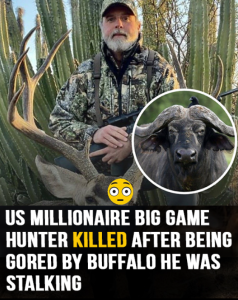Texas Ranch Millionaire Fatally Gored by Buffalo on South Africa Hunt
For most of his 62 years, Clayton “Clay” Hargrove lived a life of boundless ambition and unapologetic adventure. Known in Texas cattle country as the “Buffalo King” for the sprawling exotic game ranch he owned just outside of Kerrville, Hargrove was as comfortable in a custom-tailored suit at a Houston gala as he was in dusty boots on horseback.
Friends described him as fiercely competitive, drawn to challenges that tested both nerve and skill. So when he booked a hunting trip to South Africa’s Limpopo province this past June, few who knew him were surprised. What they could not imagine was that the man who had built his fortune and reputation around big game would meet his end in the horns of one of nature’s most dangerous creatures: the Cape buffalo.
A Trophy Hunter’s Dream Destination
Hargrove’s trip was part business, part pleasure. He’d been negotiating a deal with a safari outfitter to bring high-end hunting clients from the U.S. to South Africa. The Limpopo region, with its rugged bushveld and abundance of big game, was the crown jewel of his pitch.
On the morning of the tragedy, Hargrove and his professional hunting guide, a veteran tracker named Thabo Mbele, set out before sunrise. The air was cool, the smell of acacia and dust sharp in the breeze. Their quarry: a massive old Cape buffalo bull reported by locals to be roaming near the river—a solitary, battle-scarred veteran with a reputation for aggression.
Hunters often speak in awe and fear of these animals. Nicknamed “black death” in Africa, Cape buffalo are responsible for more fatalities on the continent than lions. Weighing up to 1,900 pounds and capable of charging at 35 miles per hour, they can kill with a single well-placed horn strike.
The Fatal Encounter
According to the official report filed by South African authorities, Hargrove and Mbele tracked the bull for nearly three hours. They moved cautiously, stopping often to read tracks in the sandy soil and listen for the telltale rustle of the beast moving through the brush.
Around 9:15 a.m., they spotted the buffalo grazing in a thicket about 80 yards away. Hargrove, experienced with large-caliber rifles, shouldered his weapon and took aim. The first shot struck the bull but did not bring it down—a dangerous scenario in buffalo hunting.
Wounded, the animal exploded from the brush, head lowered, horns forward. Mbele shouted for Hargrove to fire again. Witnesses from the backup team, who were following at a distance, said the second shot missed as the buffalo zigzagged through the bush at terrifying speed.
In less than five seconds, the bull closed the distance. It slammed into Hargrove with such force that he was thrown into the air before crashing to the ground. One horn pierced his chest; another gored his thigh. Mbele fired two rapid shots that finally dropped the buffalo, but it was too late.
Desperate Rescue Efforts
The backup team rushed forward. Mbele and another tracker tried to staunch the bleeding with field dressings while radioing for an emergency evacuation. A helicopter was dispatched from a nearby lodge, but the remote location and dense terrain delayed its arrival.
Hargrove remained conscious for several minutes, reportedly telling Mbele, “Don’t let my family see me like this.” Those were his last words. By the time the helicopter reached them, he had succumbed to massive internal injuries and blood loss.
Shockwaves Across Two Continents
News of Hargrove’s death spread quickly—first in hunting circles, then across mainstream media. In Texas, his ranching community mourned the loss of a man who had employed dozens and contributed generously to local schools and charities. In South Africa, the incident reignited debate about the risks of trophy hunting and the safety protocols for foreign hunters.
Hargrove’s widow, Caroline, released a brief statement:
“Clay lived for adventure, for the outdoors, and for the challenge of facing nature on its own terms. He died doing what he loved, and our family asks for privacy as we grieve.”
A Controversial Legacy
While some celebrated Hargrove’s adventurous spirit, others criticized the practice of hunting Cape buffalo and other African big game. Conservationists pointed out that even well-regulated hunts carry inherent dangers—not only for the animals but also for the hunters and local guides.
Supporters of Hargrove’s pursuits argued that properly managed hunting generates significant revenue for conservation and anti-poaching efforts in Africa. Indeed, part of Hargrove’s business plan had been to channel a percentage of client fees toward wildlife reserves.
Still, the fatal incident underscored the unpredictable nature of wild animal encounters.
The Dangerous Reality of Cape Buffalo
Experts say that even seasoned hunters can underestimate the resilience and aggression of Cape buffalo. A wounded buffalo is among the most dangerous situations in African hunting. Their massive muscle structure can absorb poorly placed bullets without immediately disabling them, giving them the opportunity to counterattack.
“Once they commit to a charge, there’s almost no stopping them,” said Dr. Pieter van Rooyen, a wildlife behavior specialist in Limpopo. “Your only chance is a perfectly placed shot, and under pressure, that’s very difficult.”
Final Journey Home
Hargrove’s body was flown back to Texas after an autopsy in South Africa. A private funeral service was held at his ranch, attended by family, close friends, ranch employees, and a few hunting partners from around the world.
The service included a quiet moment where his favorite saddle and rifle were placed near the casket, a nod to the life he had built and the pursuits he loved.
Aftermath in Limpopo
In Limpopo, Mbele and his team returned to the site days later. They buried the remains of the buffalo under a large acacia tree, marking the spot with a simple wooden cross. “It was a worthy adversary,” Mbele told a local reporter. “We honor it as we honor the man.”
The safari company involved has since reviewed its safety policies, considering changes to backup shooter positions and minimum caliber requirements for Cape buffalo hunts.
Remembering a Complex Man
Clayton Hargrove leaves behind a complicated legacy: a philanthropist and successful businessman, a passionate outdoorsman, and a figure who courted both admiration and controversy. Those closest to him say his life cannot be defined by the moment of his death alone.
“He took risks—sometimes too big,” said longtime friend and fellow rancher Jesse Runnels. “But that’s who he was. Clay didn’t sit in the stands. He was always in the arena.”
In the end, the story of Clayton Hargrove’s final hunt is both a cautionary tale and a testament to the unpredictable, sometimes unforgiving, power of the wild.

